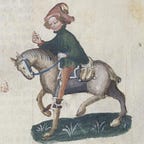The Curious Case of the Christmas Cutpurse
If you were a Londoner in 1611, you had a few things to fear: Famine, freezing temperatures, and the odd bout of plague were all competing to cause you harm. Even if you could survive these threats, the news media of the seventeenth century would have you believe there was another lurking right under your nose: An underworld of criminals, walking among well-intentioned citizens, who gathered in murky alehouses to conspire and plot, devising all kinds of clever tricks to part you from your goods.
Was this even remotely true? Well… No. Thievery was a common but unstructured, erratic, and fairly unsophisticated phenomenon — but it made a good story, and the ‘middling sort’ of early modern London were just as eager to eat up these fantastical notions as the budding writers, printers, and booksellers of St. Paul’s Churchyard were to churn it out. The dramatist Robert Greene produced a series of ‘cony-catching’ pamphlets (the term referred to thieves and pickpockets who used deception to enrich themselves), decrying the ‘secret villanies’ and ‘pernicious sleightes’ that were ‘daily practised by sundry lewd persons’. Like Greene, many of the authors of these works seemed, really, to take delight in the cunning trickery employed both by the cony-catchers themselves as well as those who sought to undermine and expose them. After all, who wouldn’t want to gain a reputation as ‘a doctor in the art of knavery’?! In any case, for the writers whose next meal relied on the financial viability of cheap crime pamphlets, pickpockets and tricksters…
